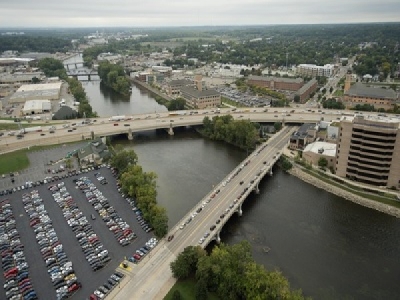
Posted on October 30, 2018
Making the Grand River accessible to power boaters looking to travel from Grand Rapids to Lake Michigan would boost tourism in the region and generate an estimated annual economic impact of $5.7 million, according to a new study.
The study, by East Lansing-based Anderson Economic Group, was conducted on behalf of Grand River Waterway, a group pushing to dredge a 23-mile stretch of the river – between Grand Rapids and the Bass River Inlet near Eastmanville Township in Ottawa County – that is unnavigable in some spots.
The group — which is still in the planning phase of the project — wants to create a 50-foot wide, 7-foot deep channel large enough to accommodate vessels that are 26-feet or larger in some instances.
Doing so would attract an estimated 33,000 residents from outside of West Michigan, who would spend an average of $125 a day and stay in the region for a day and a half, according to the study.
Project organizers envision boaters traveling to Grand Rapids from nearby communities for a day visit or an overnight stay, creating a need for marina and docking facilities near downtown amenities.
“Boating is a huge source of fun and enjoyment for families throughout Michigan,” said Shana Shroll, executive director of Grand River Waterway and a former Republican member of the Kent County Board of Commissioners. “People have boats, they love being on their boats, why have them take their boat anywhere else? Bring them here.”
Sonar survey first step in potential Grand River dredging project.
Despite the reported economic benefits, environmental advocates say there’s a lot of unanswered questions. More study is needed to determine whether dredging the river would unleash polluted sediments and hurt fish and wildlife, they say.
Also unanswered: How does the project mesh with an effort, already underway in Grand Rapids, to take out the dams along the Grand River and restore the city’s namesake rapids?
“The environmental impacts are potentially too big, they’re too negative, and I’m not confident that it’s going to bring that many boaters up the river,” said Elaine Sterrett Isely, director of water programs at the Grand Rapids-based West Michigan Environmental Action Council.
Bill Wood, the group’s executive director, echoed those concerns, but added if the project is done responsibly, it could generate greater interest in the river, thereby creating more advocates for “keeping the river healthy.”
“It’s going to need to play out a little bit,” he said of the project proposal.
The project carries an estimated price tag of $2.2 million, a figure that covers engineering, dredging, disposal of materials and the cost of installing buoys. It would also require about $165,000 to cover annual maintenance costs. Those figures were determined by a state-contracted underwater study, released last year, of the Grand River between downtown Grand Rapids and the Bass River inlet.
Shroll said her group is conscious of the project’s environmental impact. She said her group will commission studies to examine how the dredging would impact wildlife and take sediment samples to “make sure we’re not disrupting any toxins that are in the river bed itself.”
“It’s about improving the accessibility for boats,” she said. “It’s not about harming the wildlife or doing anything unnatural.”
She’s working on the project with Dan Hibma, a West Michigan developer who has been pushing the idea for years. He is the husband of former Secretary of State Terri Lynn Land and partner at apartment complex owner Land & Co.
He has been pitching local municipalities for years on a recreational boating link between Grand Rapids and the lakeshore, and has said his plan would “complement” the planned downtown rapids restoration project.
Matt Chapman, director and project coordinator of Grand Rapids Whitewater, declined to comment on the project, saying: “We do not have enough information about the Grand River Waterway project to understand the potential impacts or benefits. We are focused on continuing to work with our community partners on the revitalization of the Grand River through downtown Grand Rapids.”
The Anderson Economic Group study cost $60,000 and was funded through a $200,000 grant from the Michigan Economic Development Corporation, Shroll said.
In addition to drawing more visitors to the region, the project could boost property values, according to the study.
It estimates that dredging along the 23-mile stretch could “add 16.9 percent, or $54.4 million, among the hundreds of residential properties along the Grand River, resulting in increased property tax collections of about $614,000 for municipalities along the river.”
“The Grand River is an incredible asset to our region, and with a very modest investment the river can be a vital component to the continued growth in the region,” Rick Baker, president, Grand Rapids Area Chamber of Commerce, said in statement included in the press release announcing the results of the economic impact study. “The economic impact study only begins to scratch the surface of the potential residential and commercial benefits all along the river, from downtown Grand Rapids to Lake Michigan.”
Shroll said her group has spoken about the project with some mayors and township supervisors, but has not yet done any outreach to the public at large.
“We’re just not at that stage yet,” she said. “This is really just preliminary study period.”
Source: mLIVE





